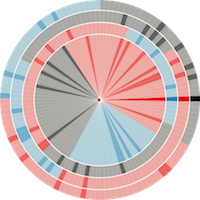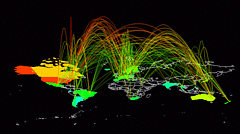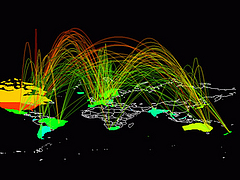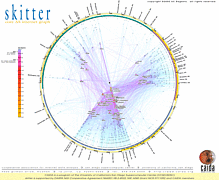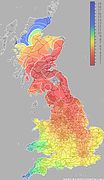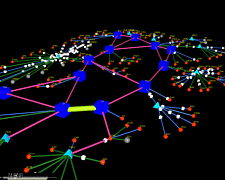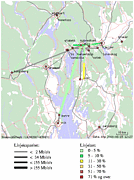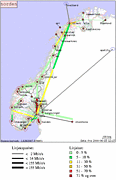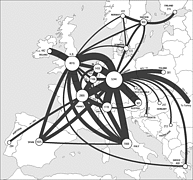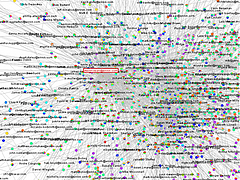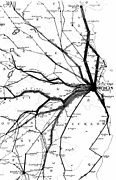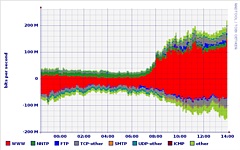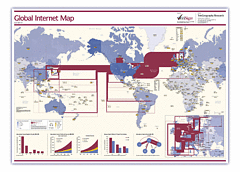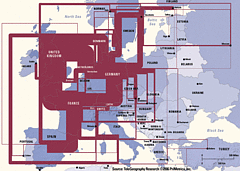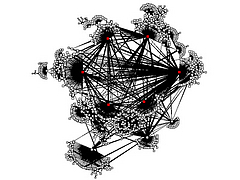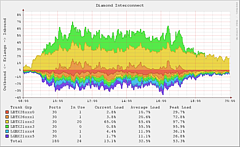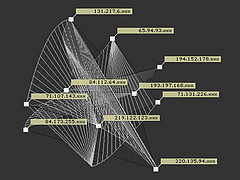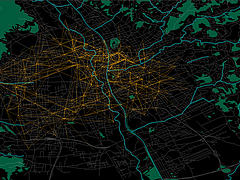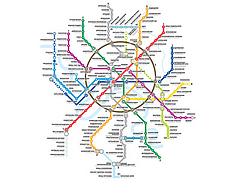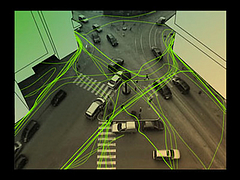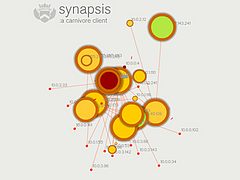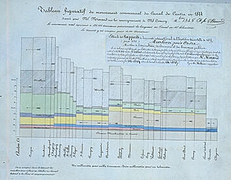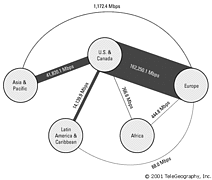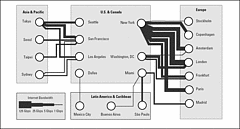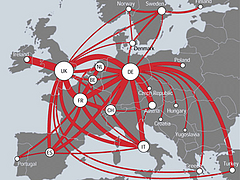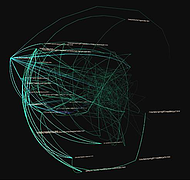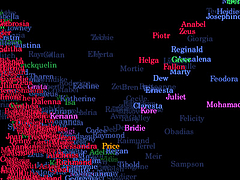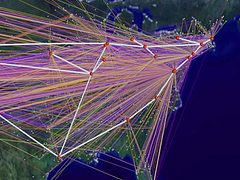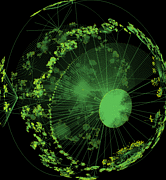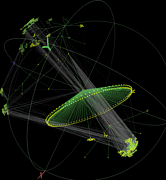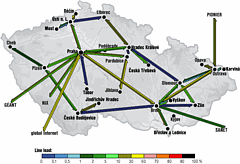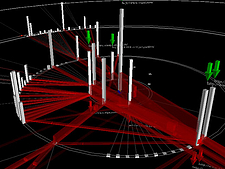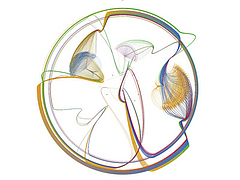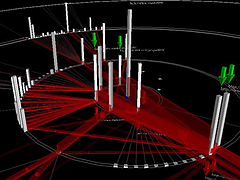Found 49 results for "traffic":
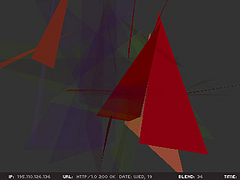 885 885 | 2002 computer graphics by (unknown) Limiteazero is an architecture, media design and media art studio based in Milan, Italy. Among it's rich portfolio in installation/exhibition design, sound design and new media, they created a Carnivore client with audio/visual feedback, entitled Active Metaphor. The basis of the project is the "Carnivore" engine, a software application that listens to all internet traffic on a specific local network. Carnivore was created by RSG and has won Golden Nica at Ars Electronica and an honorable mention at read_me 1.2. The authors made a script that gets the ip address ("aaa.bbb.ccc.ddd"), and breaks it down into four different groups of numbers ("aaa", "bbb","ccc", "ddd"). These elements are used as coordinates for 3D shapes and blending percentages ("x", "y", "z", "blend"). They choose to work with ip addresses because: "it's the main data that identifies an Internet relationship. Users identify their interaction by requesting ip addresses, even if they're not aware of it. Each ip address flowing over the net could be thought of as a human action, a communication, or an experience." This piece of work lets the user see and hear the data flow, which is something that we normally can't perceive. It allows us to see the net as a huge data field that is constantly moving, like a digital life-form that feeds itself with human interaction. |
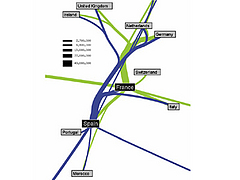 927 927 | 2005 computer graphics by Doantam Phan, Ling Xiao, Ron Yeh Flow Map Layout is a novel visualization technique seen as a hybrid of graphs and flow maps. Cartographers have long used flow maps to show the movement of objects from one location to another, such as the number of people in a migration, the amount of goods being traded, or the number of packets in a network. One of the most famous flow maps, depicting Napoleon's Russian Campaign, was created by Charles Joseph Minard in 1869, and can be seen here. The advantage of flow maps is that they reduce visual clutter by merging edges. Most flow maps are drawn by hand and there are few computer algorithms available. In Flow Map Layout, the authors present a method for generating flow maps using hierarchical clustering given a set of nodes, positions, and flow data between the nodes. The technique is inspired by graph layout algorithms that minimize edge crossings and distort node positions, while maintaining their relative position to one another. The authors have demonstrated the technique by producing flow maps for network traffic, census data, and trade data. The first image illustrates a close-up of top 15 imports to Spain and France. Notice the branching structure is shared across different nodes, for example Spain, and France branch to the Netherlands, Germany and the UK in the same way. The second image represents an outgoing migration map from Colorado (USA) from 1995-2000, generated by the algorithm without layout adjustment or edge routing. |
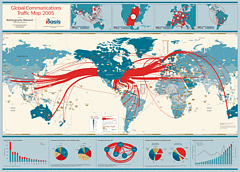 611 611 | 2005 computer graphics by TeleGeography |
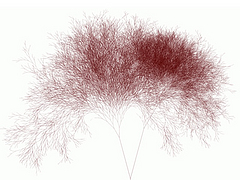 1059 1059 | 2006 computer graphics by (unknown) 2,147,483,647 web pages ('nodes') were numbered and arranged in a Binary Search Tree. For each page the traffic of the three major search bots (Yahoo! Slurp, Googlebot and msnbot) was monitored over a period of one year (between 2005-4-13 and 2006-4-13). Each search engine's behavior was visualized as a tree image that represents which nodes were crawled. Each line in the image represents a node, the number of times a search bot visited the node determines the length of the line. As part of the results, the authors found Yahoo! Slurp to be the most active search bot and the first search engine to discover the Binary Search Tree experiment. In the first hours after discovery it crawled the tree vigorously, at a speed of over 2.3 nodes per second. The image shown represents the resulting tree of Yahoo! Slurp crawling over 1 year. |
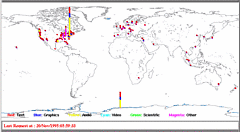 319 319 | 1995 computer graphics by Evangelos P. Markatos and Athanasios E. Papathanasiou, Institute of Computer Science (ICS), Foundation for Research & Technology - Hellas (FORTH), Crete. |
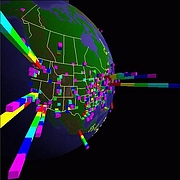 310 310 | computer graphics by Stephen E. Lamm and Daniel A. Reed, Department of Computer Science, University of Illinois, USA |
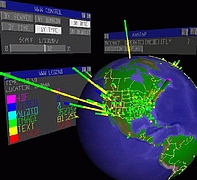 311 311 | computer graphics by Stephen E. Lamm and Daniel A. Reed, Department of Computer Science, University of Illinois, USA |
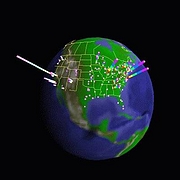 312 312 | computer graphics by Stephen E. Lamm and Daniel A. Reed, Department of Computer Science, University of Illinois, USA |
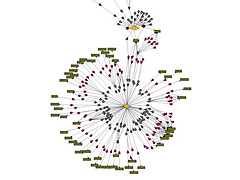 980 980 | 2003 computer graphics by Ed Blanchfield Ed Blanchfield used a Firewall/Intrusion Detection System (IDS) log data to get "before" and "after" graphs showing the impact of an MS-SQL worm, which hit the Internet around January 25th 2003. When this particular worm hit a large class B sized network, an IDS system designed and implemented by Blanchfield for a large managed services provider, was one of the first sites in the world to detect and report the incident. Ed posted his original findings and info to various security lists and quickly wrote up a parser to create GDL files from Firewall and IDS logs, which he fed into aiSee Graph Layout Software in order to visually map this worm's effect on their customer's network. The first image is a visualization of log data for a class B firewall without background worm traffic, while the second represents the same data with background worm traffic. The graphs show just 15 minutes worth of traffic at midnight, but the impact of the worm is already clearly visible. You can imagine what 24 hours must have been like. |
 1408 1408 | UK Road Traffic Accidents: A Leading Killer2012 Image by Pannone |
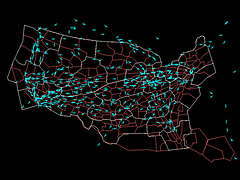 934 934 | 2000 computer graphics by Karl Bilimoria, Banavar Sridhar An efficient and effective air traffic management system is vital to the U.S. transportation infrastructure. Since 1978, when the airline industry was deregulated, the inflation adjusted gross domestic product (GDP) has increased by 62 percent. In this same time period, total output of scheduled passenger air transportation (as measured by Revenue Passenger Miles) has increased by 190 percent and total airfreight ton miles have increased by 289 percent. Since 1997, flight delays have skyrocketed - doubling in only four years. These trends are expected to continue. In 1998, airline delays in the U.S. cost industry and passengers $4.5 billion -- the equivalent of a 7 percent tax on every dollar collected by all the domestic airlines combined. These screenshots are from an quicktime animation created with Future ATM Concepts Evaluation Tool (FACET) by NASA. It represents a day in the life of Air Traffic over the continental USA. The animation illustrates critical patterns on major airports and it's quite interesting to notice the different traffic intensity throughout the day. For more information one can read the paper here. |
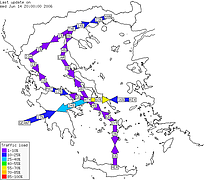 508 508 | computer graphics This is the weather map for the GRNET, the education and research network for Greece. Clicking on individual link arrows brings up more detailed traffic graphs. |
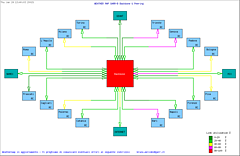 503 503 | computer graphics Weather maps can also use non-geographic, topological diagrams to represent the network structure. This example diagram shows the traffic load on the GARR-B network in Italy. |
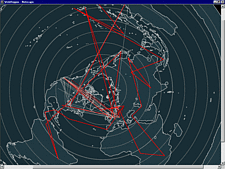 325 325 | computer graphics by Sensorium WebHopper was an experimental mapping of Internet traffic in real-time. |
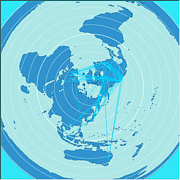 326 326 | computer graphics by Sensorium WebHopper was an experimental mapping of Internet traffic in real-time. |
